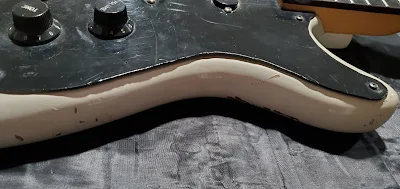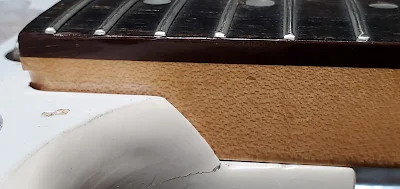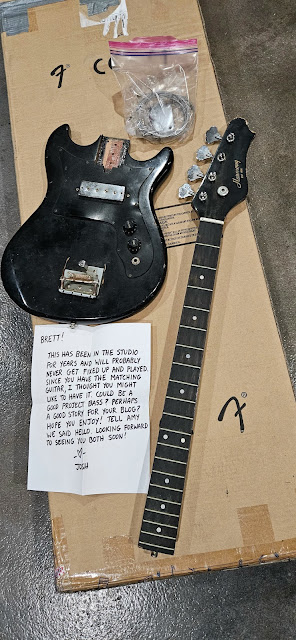Among the myriad of mysteries surrounding the Harmony H 804, one conundrum has risen above all others: How did I not notice the twist in the neck? Sure, I was excited about a project, and sure, a professional may be able to correct it. However, I am no pro, and I am not about to pay one the amount it would cost to attempt to fix it. I assume, despite my constant running of humidifiers, with the low Colorado humidity all my guitars may one day suffer the same fate.
New worst case: The H 804 becomes wall art. I still have hope that it will function as a post post-punk garage-jazz ballad-thrash machine. Onward we tinker!
Let's give this (twisted) neck some love! I did a bit of fret polishing, and oiled the dry-as a high-altitude desert-fretboard. It darkened up quite a bit.
I imagine that even in 1980 these were advertised as "vintage style tuners." A little bit of lube and screw adjustments, and they are all now turning. Hopefully they hold string tension.
I was anxious to bolt the neck back to the body, just so it would look a little more like a guitar again, but before the neck was in the way I had to start a future part of the rehab I am dreading: the pickguard.
You see, the pickguard on this thing was obviously "hand-crafted" in a general ode to the original, but it actually overhangs the curve of the body in places, and is cracked here and there, including the holes which hold and level the pickups.
Which leads to the next expense, $16.02 for a black pickguard blank which I will attempt to make slightly more functional and aesthetically pleasing. It is a big enough blank for two tries, or perhaps a black picky-picky on my Mustang bass?
I decided to start from scratch and free-hand trace through a piece of wax paper. Anyone have any better ideas I am open to suggestions! I contacted a dealer in Tennessee named Jack Brunson, who owns and sells a number of these guitars, hoping I could float him a few bucks and he could trace one of his pickguards on some paper and drop it in the mail. He offered to sell me a white loaded pickguard for $75, but didn't want to open the sealed packaging and unbolt everything, which I fully understand. I appreciated the offer of the loaded pickguard (no soldering!) but this is DIY, not DI-Buy, right?
If you want to buy one of these guitars, Jack's store is called Jack's Guitarcheology and he has one up on Reverb in much better condition than mine!
Did I mention I have a supervisor?
I found a couple of bolts for the tail-piece. Which is quite an interesting little hunk of metal. At first glance, it looks like a bridge cover, but there are little forks in there to hook your strings into.
As you can see with the bridge, there's nothing but little string grooves and the height knobs. There will be no intonation adjustments here, folks.
Before disassembly, I noticed the bridge was buried and the string height was still a bit much, also not giving much of a breaking angle to keep the strings in those little bridge slots. I've heard of folks shoving just about anything in there to shim the neck. I've seen brand-new Squiers with a bit of sandpaper folded up. I assume an attentive dealer did that? Regardless, I had a broken bass neck shim from Stew-Mac so I taped a piece of it in there.
You can see from the color on the side of the neck and the little gap against the body how much the shim moved things. Too much? Time will tell.
Next Up: Sometimes You Feel Like A Nut










Comments
Post a Comment